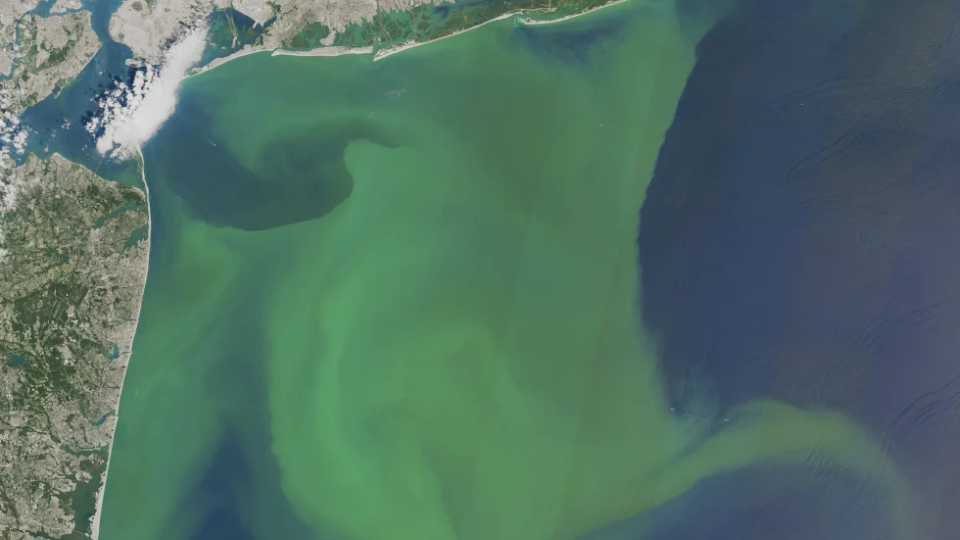Supreme Court curbs ability to clean up environmental disasters
June 3, 2025

A “deadzone” off the coasts of New York and New Jersey. This dead zone, and similar ones along the Gulf Coast, are often caused by polluted river water flowing into the ocean from many miles to the north or west. The Supreme Court now says environmental impact statements can’t include damage when the cause is a site many miles away. They can only include damage in the immediate surroundings of the site.| NASA via AP
WASHINGTON—In a blow to the green movement—and to workers affected by downstream air and water pollution from big-ticket projects—the Supreme Court limited the reach of environmental impact statements only to the project involved, and not to its upstream or downstream impacts.
The 8-0 decision came in the case involving a planned 88-mile-long railroad from Utah’s Uinta oil field to major freight rail lines. The railroad would carry tank cars from the field to those lines, where they could be hitched onto freight trains headed for big oil refineries, notably in Texas and Louisiana.
Seven Utah counties pushed the federal government to issue an environmental impact statement (EIS) covering only the local Utah rail line. Foes, including green groups and a Colorado county, pushed the federal government to say the EIS must also cover not just drilling for oil and its transport on freight cars from Uinta but the impact all the way down the line to the oil’s ultimate destinations, the refineries.
The U.S. Surface Transportation Board, which handled the paperwork to approve or deny the rail line, agreed to consider the down-the-line impact, too. It produced a 3600-page EIS. Then the board approved the local freight line, anyway.
Challenge by Green Groups
Green groups and a Colorado county challenged that and won in the D.C. appeals court, but lost in the Supreme Court. The justices ruled for the rail line, the board, the Utah counties, and for agencies’ continued power to make such decisions without constantly looking over their shoulders for courts.
“Simply stated, the National Environmental Policy Act is a procedural cross-check, not a substantive roadblock. The goal of the law is to inform agency decision making, not to paralyze it,” Justice Brett Kavanaugh wrote. EISs should only be “an adequate report” on a specific project’s local impact.
The ruling gives another big break to the nation’s corporate class. It has long hated EISs and especially hated green groups, which used the 1970 National Environmental Protection Act’s EIS requirement to slow or stop projects. The rail line is one example. Though the Surface Transportation Board OKed it in late 2020, the lawsuit over the EIS has delayed its groundbreaking since then.
Courts “slowed down or blocked many projects and, in turn, caused litigation-averse agencies to take ever more time and to prepare even longer EISs for future projects,” Kavanaugh wrote.
“NEPA has transformed from a modest procedural requirement into a blunt and haphazard tool employed by project opponents–who may not always be entirely motivated by concern for the environment–to try to stop or at least slow down new infrastructure and construction projects.”
The D.C. Circuit Court of Appeals, which heard the complaint from the rail line’s environmental and downstream foes, had ruled for them.
Though Justices Sonia Sotomayor, Ketanji Brown Jackson, and Elena Kagan agreed with the ruling, they said the five GOP-named justices, led by Kavanaugh, did not have to ground their decision in the
policy impact of an EIS. They also pointed out the Surface Transportation Board could not reject railroad construction applications based on what products the railroads would carry—the oil—and how it would carry the oil, in the tank cars.
Justice Sotomayor said the appeals court went too far when it mandated the board “to consider in further detail the harms caused by the oil industry” in the EIS for the rail line.
But the High Court was actually following Congress, which in turn was influenced by corporate lobbying, clout, and campaign contributions.
During the Biden administration, lawmakers mandated that environmental impact statements not become an absolute block to projects. Kavanaugh said in a footnote that a 2023 law mandated that the statements be no more than 150 pages long, and that the EPA take no more than two years to evaluate a specific project and its alternatives.
“That strongly reinforces the basic principles that the National Environmental Policy Act, correctly interpreted, already embodied but that have been too often overlooked,” the justice wrote.
Green groups contacted had no immediate comment on the ruling.
We hope you appreciated this article. At People’s World, we believe news and information should be free and accessible to all, but we need your help. Our journalism is free of corporate influence and paywalls because we are totally reader-supported. Only you, our readers and supporters, make this possible. If you enjoy reading People’s World and the stories we bring you, please support our work by donating or becoming a monthly sustainer today. Thank you!
Search
RECENT PRESS RELEASES
Related Post




